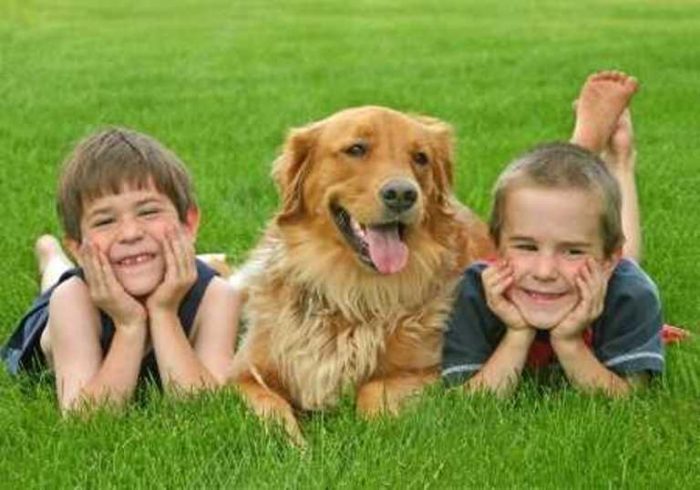The Golden Retriever is among the most popular breed of dogs in the US, thanks to their tolerant and friendly attitude that makes them great family pets. Goldens are also classified as working dogs with high energy levels, thus, families that opt to keep the pup as pets must be ready to provide them with both mental and physical stimulations on a daily basis.
As the name suggests, the breed is known to excel at retrieving games, sniffing, and tracking, making them the perfect hunter’s companion. They have also been used as therapy dogs, service dogs, as well as for participating in dog sports. Also, law enforcement agents have used them on several occasions in sniffing out contraband goods.
Table of Contents
History Of The Golden Retriever
The Golden Retriever breed was developed in the mid-to-late 1800s by the first Lord of Tweedmouth, Dudley Marjoribanks. Though indications from rumors at that time showed that the breed was a descendant of the Russian sheepdogs, the Golden was in fact created in the Scottish Highlands. It took Marjoribanks over 50 years to arrive at the ideal gundog. Being an avid waterfowl hunter, his desire was to develop a breed suitable for the rugged terrain and rainy climes of his area and at the same time, be even-tempered at home. This led Lord Dudley to cross his “Yellow Retriever “and the “Tweed Water Spaniel” (now extinct).
Their descendants were later crossed with other breeds like flat-coated retrievers, a red setter, and another Tweed Water Spaniel. Dudley selected the yellowish puppies to continue his cross-breeding program while he gave the others away and gradually, he arrived at what is known today as the Golden Retriever.
The Golden Retriever’s first official outing was in 1908 when it appeared in the British Dog Show. It was officially recognized as a distinct breed by the Kennel Club in England in 1911. Then, the breed was classified under “retriever — yellow or golden.” However, it became officially known as Golden Retriever in 1920. The Golden was brought into the US via Canada in 1910 and in1932; it gained the recognition of the American Kennel Club.
Physical traits
The pup is distinguished by its double-coated body with water repellent qualities. The texture of their coats varies from straight to wavy and there is evidence of heavy feathering on their backs, chests, tail, and back of their hind limbs.
Its build is described as medium-sized, muscular, and sturdy, and the dog got its name from its dense, shiny coat of gold, however, we have seen variations like cream, lightly golden, and dark golden. A broadhead houses a pair of intelligent and friendly eyes, a straight muzzle, and fold-over ears.
According to the standard set by AKC, the Golden Retriever moves with a smooth and powerful gait, carrying its feathery tail with what can be best described as a “merry action,” breed fanciers say. While the female Goldens weigh from 55 to 65 pounds with 21.5-22.5 inches in height, the males can take it to 65–75 pounds with 23-24 inches height.
Grooming
The dog is a double-coated breed with dense water repellent furs that sheds heavily during the fall and spring and moderately in summer and winter. For this, daily brushing is recommended to get rid of dead hairs and keep the tangles at bay. Baths can come once a month.
Nail trimming can be done once or twice monthly and to prevent periodontal disease, you should get rid of tartar build-ups by brushing the dog’s teeth two or three times weekly. The breed is known for its fold-over ears, which engenders an enabling environment for the growth of fungus and bacteria. Because of this, the ears should be subjected to regular checks and should be cleaned with cotton buds moistened with gentle, pH-balanced ear cleaner when dirty; this helps prevent infections.
Temperament
The Golden Retriever breed is considered to be trustworthy, outgoing, loyal, intelligent, eager-to-please, and easily trainable. The dog takes a playful and joyous approach to life, retaining its puppyish behaviors right into adulthood. It is known to be a powerful and energetic gundog that enjoys playing in the great outdoors. Being a retriever breed, it goes without saying that the pup is “mouthy” and happiest with things to carry in its mouths like newspaper, balls, toys, and sticks.
Feeding
Two to three cups of high-quality kibble (dry) are recommended for your Golden Retriever daily, but this has to be divided into two meals, morning and evening. The breed is susceptible to getting overweight, thus, free-feeding is not recommended, besides, moderation is the key when it comes to feeding the dog. Also, remember that the quantity of kibble that can be consumed by any dog depends on things like size, age, activity level, metabolism level, etc. An active dog is sure to consume more food than an inactive one.
Use the hands-on test and eye test to check if your pet is tilting towards overweight. For one, you should be able to decipher the dog’s weight by merely looking down at him. Next, with your hands on the pup’s back, fingers spreading downwards, and thumbs along the spine, the dog’s ribs should be felt without applying too much pressure. If you are not able to feel the ribs, then obesity is already setting in and the food ration must be reduced and exercise increased.
Exercise Needs

The Golden is a working dog that is used to physically demanding jobs, thus, it goes without saying that it will be in constant need of daily exercise. You can take your pooch along on long runs, hikes, bike rides, swims, field trials, hunting trips, and free time in the yard. You won’t go wrong with canine sports like obedience, agility, and tracking training. Even inside the house, the Golden must be provided with something to do like retrieving the paper, indulging in a game of fetch, or waking up the members of its family.
Failure to engage your Golden Retriever in daily vigorous exercise may result in unpalatable behaviors like chewing and digging.
Training
Early socialization is essential in raising the breed, if possible, enroll your Golden in puppy training classes where they will get exposure to a wide variety of places, people, and situations; this aids them in adjusting to life as they advance.
Being a loyal dog, Goldens are easy to train and can be exposed to mental challenges like puzzle toys and learning tricks, however, these should never replace the dog’s normal exercise sessions.
https://youtu.be/7TnhOaLUXQY
Health
Typically, the life expectancy of the Golden Retriever breed is between 10 to 12 years. According to their health records, Goldens are generally healthy but are susceptible to illnesses like cancer and hip dysplasia. Though not too common, Golden Retriever parents should also be aware of health conditions like cataracts, elbow dysplasia, progressive retinal atrophy, gastric dilatation-volvulus (bloat), hypothyroidism, and allergies.
Read Also: Australian Shepherd Golden Retriever Mix: Facts To Know
Do Golden Retrievers Make Great Family Dogs?
The breed is a typical family dog and must be integrated into the pack. People who adopt a Golden Retriever must be willing to have the dog constantly underfoot daily. The dog tends to follow you everywhere and must be included in all family activities.
They Are Great With Children

Golden Retrievers are just so amiable and are never bothered by loud noise; this makes them the perfect dog for children. The dog is ready to play with kids from morning until dawn and seems to thrive on the noise from them. However, since the Golden is a large dog, it needs to be supervised in the company of very small children as it can knock them over by mistake.
Even older children must be instructed on how to interact with dogs. They should never approach a dog that is eating, or sleeping, and should never attempt to make away with the dog’s food. Pulling of the ear and tail should be avoided to evade dog bites.
The Dog Thrives In A Multi-pet Home
This dog breed is a friend to all, including other household pets aside from dogs. The breed loves to be in the company of other pets and enjoys their companionship. However, the introduction must be properly done and if you want to get the best results, all your pets should grow up together. Goldens can be trusted in the company of rabbits, cats, and other household pets.
For those who love animals and keep different kinds of them as pets at home, the Golden Retriever will relieve your concern about getting your dog to get along with your other members of the family.
